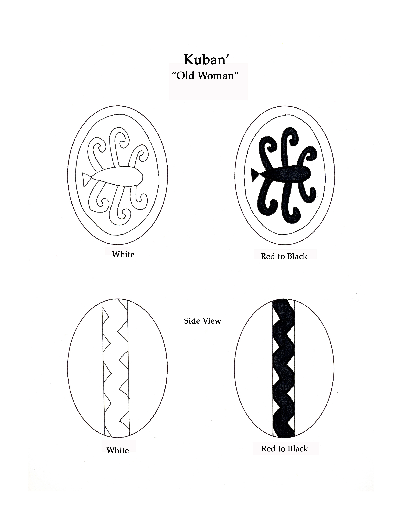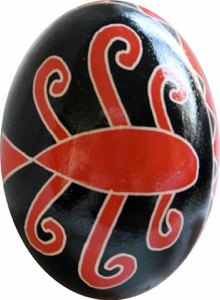Kuban
Кубанщина
Kuban
Кубанщина

The earliest version of this pysanka I have found is in Kulzhynsky (№ 15, XXXI-5); he gives its provenance as the town of Temriuk in Kuban. No name is given for this pysanka..

It appears Binyashevsky’s book; Onyshchuk also includes it in hers. Both refer to the design as being a «стара баба» or “old grandmother” (or crone). (Note: the pattern below is based on the Onyshchuk version of the pysanka, so the band varies from that of Kulzhynsky).
This is a classic example of of a «берегиня» (berehynia, “goddess”). On this pysanka the goddess has been turned onto her side, but you can clearly see the head and three pairs of arms. The berehynia is usually portrayed with two, four or six arms, raised up as in an Oranta icon.
The berehynia has been reinterpreted in post pagan times as a queen, princess, young lady or old woman. This version of the berehynia (on her side) is sometimes called a «рачок» (rachok, “crayfish”), because of her resemblance to the crustacean.
Pysanky from Kuban are largely geometric, with a color scheme of white, red and black. Kulzhynski collected 12 designs from Temriuk, all with this color scheme. Another well-known design from this region is the pysanka below, which first appeared in Kulzhynsky (№ 24, XXXI-7). No name is given for this pysanka, either.

The Elyjiws included this pysanka in their Plast stamps, and gave it the name «Циганські дороги» (Gypsy Roads). Binyashevsky used the pattern of this pysanka for the cover of book, but did not include it in the plates. Zenon Elyjiw apparently reconsidered, and in his book labelled this pysanka as coming from Podillia.
Kuban is another of of Ukraine’s lost territories. The region along the Kuban river was first settled in 1792 by kozaks from the Black Sea and Don hosts, with later waves of migration from Ukraine’s northeast areas (Chernihiv, Poltava and Kharkiv). A Soviet map from 1928 identifies it as a predominantly Ukrainian-speaking area. In the years since, massive Russification efforts have taken place, along with decimation of the Ukrainian population by the Holodomor (famine-genocide in 1932-33) and repression and deportation/exile of intellectuals, writers and Ukrainian language teachers.

Technical details: This is a moderately difficult pysanka, as it has longitudinal circumferential lines and a lot of curvilinear features. It has a basic “Lateral” division.
As with most simple traditional designs, a medium or heavy stylus is best for the lines, and of course a heavy one for waxing in.
This pattern utilizes red and black dyes.
While this is not an incredibly complex or intricate pattern, it’s not a good one for absolute beginners, unless they have a high frustration threshold and steady hand. The curved arms can be challenging, and the circumferential band frustrating. Make sure they realize that this patter gives two views of the same pysanka, and not designs for two different pysanky.
Download this pattern sheet:
Back to MAIN Patterns page.
Back to MAIN Regional Pysanky page.
Back to MAIN Traditional Pysanky page.
Search my site with Google
Old Woman
Стара баба
